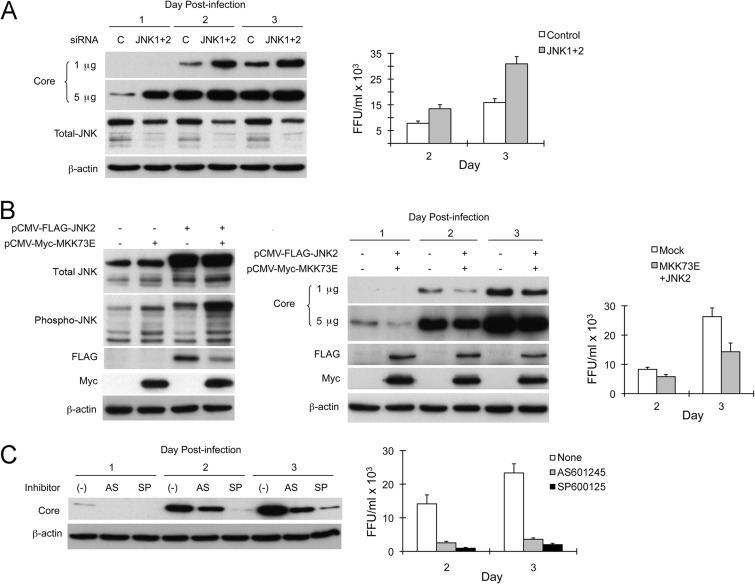Fig 2.
Contrasting effects of genetic manipulation versus chemical inhibition of JNK on infection with cell-free HCV. (A) JNK knockdown enhances the replication of HCV in Huh-7 cells. (Left) Cells were transfected with negative-control or JNK1- and JNK2-specific siRNAs prior to inoculation with HJ3-5 virus at an MOI of 2. Cell lysates prepared 1, 2, and 3 days postinfection were assayed for core, JNK, and β-actin proteins. Immunoblottings for core protein were carried out using 1 or 5 μg of total protein resolved in each lane. (Right) HJ3-5 virus titers in supernatant media collected 2 and 3 days postinfection. Error bars indicate SD in replicate experiments. (B) JNK activation suppresses HCV replication in Huh-7 cells. (Left) Cells were transfected with expression vectors for JNK2 (pCMV-FLAG-JNK2) and constitutively active MKK7 (pCMV-Myc-MKK73E). After incubation for 2 days, cells were harvested, followed by immunoblot analyses for total and phosphorylated JNK, ectopically expressed JNK2 (using anti-FLAG antibody), ectopically expressed MKK73E (using anti-Myc antibody), and β-actin. (Middle) Cells were cotransfected with pCMV-FLAG-JNK2 and pCMV-Myc-MKK73E or were transfected only with an equal amount of empty vector (pcDNA6/V5-HisB) prior to inoculation with HJ3-5 virus. Cells were harvested 1, 2, and 3 days later, and lysates were assayed for core, FLAG (tagged to JNK2), Myc (tagged to MKK73E), and β-actin proteins. (Right) HJ3-5 virus titers in supernatant fluids were determined 2 and 3 days postinfection. (C) JNK inhibitors AS601245 and SP600125 suppress infection by cell-free virus. (Left) Cells were pretreated with 2.5 μM AS601245, 10 μM SP600125, or DMSO 1 h prior to inoculation with HJ3-5 virus at an MOI of 2. Cells were then cultured in media containing the inhibitors for 1, 2, and 3 days prior to preparation of lysates for assay of core and β-actin proteins. (Right) HJ3-5 virus titers in supernatant fluids 2 and 3 days postinfection.

